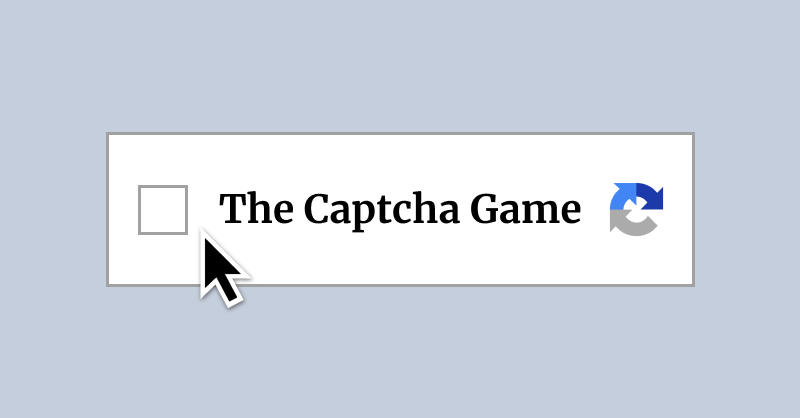Turn dominoes into a daily deduction ritual
Solve crisp domino logic boards from the NYT. Deduce placements, satisfy edge clues, and enjoy a fresh daily brain workout that sharpens focus and pattern reading.
Keep exploring
Keep your night shift energy up with more browser horror, tense escape rooms, and quick palate cleansers we trust.

Polytrack — Build Tracks, Chase PBs
Polytrack — Build Tracks, Chase PBs

Wall-jump your way across a sugar-sweet world
Wall-jump your way across a sugar-sweet world

The Captcha Game
The Captcha Game

Play Clasherdle — Five Guesses, Smart Hints
Play Clasherdle — Five Guesses, Smart Hints

One tab, countless voxel adventures
One tab, countless voxel adventures

All elemental shrines in one seamless quest
All elemental shrines in one seamless quest

Beat Verification at Arcade Speed
Beat Verification at Arcade Speed

Assemble Chiikawa & friends from fading clues
Assemble Chiikawa & friends from fading clues

Dino Game — Sprint, Jump, Repeat
Dino Game — Sprint, Jump, Repeat

Check the box—then survive the chaos
Check the box—then survive the chaos
A fresh, tactile twist on logic puzzles
What this domino puzzle is all about
This elegant browser puzzle turns classic domino tiles into a clean, modern logic challenge. Around the border of each grid you will find small numbered hints. Those numbers tell you how many pip halves must occupy the cells that align with that edge. Your goal is to place standard dominoes so that every dot has a partner, all edge counts are satisfied, and no rules are violated. It feels familiar if you enjoy Sudoku, Nonograms, or Kakuro, but the tile-based format adds a pleasingly physical vibe—every correct placement clicks into place like a tiny victory.
Because the board uses full domino pieces that cover two cells, you are constantly reasoning about pairs, adjacencies, and exhaustible counts. The best solves come from balancing hard deductions with gentle speculation: mark a few candidates, follow the consequences, then commit only once the picture becomes inevitable. That mix makes each daily board an ideal coffee-break ritual—short enough to fit in a spare moment, deep enough to leave you satisfied.
How to read the board at a glance
Start by scanning the outer numbers. A border showing zero means no pip halves can sit in that entire line of cells, which immediately forbids certain placements. A maximum value for a small region signals the opposite: every available spot along that edge must contain dots, forcing tiles to cover those cells somehow. As you track these extremes, you’ll see forced domino orientations emerge—vertical in some columns, horizontal in some rows. Whenever a tile is placed, it reduces remaining counts along multiple edges at once, creating a cascade of deductions you can exploit.
Concrete first moves that rarely fail
Look for narrow corridors, dead-end corners, and two-cell pockets, because any domino covering them has only one or two legal orientations. If an edge requires all possible pips in a short span, fill that span early. Conversely, if an edge requires none, block the corridor in your notes so you don’t waste time testing illegal placements. In small boards especially, a single zero or maximum is often enough to anchor your first few tiles.
A disciplined approach to deduction
Efficient solvers follow a simple loop: identify certainty, propagate consequences, and only then entertain hypotheses. Certainty comes from hard constraints like zeros, maximums, and single-orientation pockets. Propagate by updating border counts and striking out newly forbidden cells. When the board stalls, choose the hypothesis that forks the fewest branches—often a nearly forced placement in a bottleneck. Trace its implications for two or three steps. If you hit a contradiction (an edge count can’t be satisfied or a region strands a single pip half), roll back that guess and lock the alternative. This is classic pencil-and-paper technique elevated by the tidy grid and clear feedback.
Edge counts as a running ledger
Think of the border numbers as a live budget. Each time you place a tile that adds dots to an edge’s span, you spend from that budget. If a budget hits zero, mark all remaining cells along that span as dot-free. If a budget equals the number of still-open pip slots, every one of those must be filled by the end of the solve. Keeping this ledger straight is the difference between a clean solve and chasing ghosts for ten minutes.
Common mistakes and how to avoid them
Overcommitting early: The most frequent error is locking a speculative placement before it’s justified. Use candidate marks liberally and commit only when an edge budget or pocket truly forces it.
Ignoring parity and coverage: Dominoes always occupy cells in pairs. If a corridor contains an odd number of must-fill cells, something is wrong with your assumptions. Parity checks expose hidden contradictions fast.
Forgetting cross-effects: A single tile touches multiple edges and regions. After any placement, pause to update every affected budget; many quiet deductions appear only once the ledgers are refreshed.
Advanced patterns to recognize
Chokepoint corridors: Long, one-cell-wide lanes behave like tracks; once an edge demands dots in those lanes, orientations become heavily constrained and can sometimes be solved end-to-end.
Mirror pressure: If two opposite edges impose tight budgets on the same set of cells, you can often calculate exact distributions without guessing. Write tiny tallies inside the lane to track how much capacity remains for each side.
Sandwich tiles: When a cluster of cells is flanked by a zero on one side and a high count on the other, tiles must lie flush to the high-count edge, producing forced orientations you can chain through the cluster.
Speed-solving workflow for dailies
Veteran players tend to solve in three passes. Pass one: harvest every forced placement from zeros, maximums, and two-cell pockets. Pass two: run the ledger—balance budgets, strike impossibilities, and look for parity warnings. Pass three: introduce the smallest necessary hypothesis, play it forward several consequences, and accept or reject it decisively. This rhythm keeps boards brisk and minimizes dead time.
Keyboard and mouse tips
If your setup supports it, use quick-toggle keys for candidate marks and confirmed placements. Map a single key to cycle orientations so you can test fits without dragging the mouse constantly. Small optimizations like these add up, especially on larger grids where travel time across the board compounds.
Why this puzzle scratches the right itch
There’s a particular satisfaction in pairwise reasoning: every move is small, local, and checkable. Yet the solution depends on global harmony, because the same tile influences multiple borders. That balance rewards careful thinkers who enjoy seeing a plan unfold. The daily format adds structure—you know there will be a fresh challenge tomorrow, and an archive to binge if you’re in the mood—so improvement feels measurable over a week or two as your eye learns to spot chokepoints and your ledger work becomes second nature.
Improve steadily with micro-habits
Time yourself once per day for a week and jot three bullets after each solve: the first forced placement you spotted, the first contradiction you found, and the moment the board “broke open.” Reviewing those notes quickly reveals patterns in how you think. Many players discover they either guess too early or update ledgers too slowly—two habits that are easy to fix once you notice them.
Approach for beginners
New to logic puzzles? Start by treating every edge number as either a red light (zero) or a green light (maximum) and ignore middling values until later. Fill or block the extremes, then revisit the remaining budgets. You’ll often find the medium numbers have become effectively extreme because so many cells are already determined. This staged approach builds confidence and teaches you to see propagation chains.
Approach for experts
If you’re comfortable with advanced Sudoku techniques, you can import similar ideas here: look for strong links (a cell must be dotted if its alternative would contradict edge budgets) and use forcing chains to collapse ambiguity. Tallies, dotted candidates, and cautious bifurcations will carry you through the trickiest grids.
Final note
Whether you’re penciling in your first domino or shaving seconds off a daily solve, stay curious and let the board teach you. Each click aligns another piece of logic, and that quiet snap of certainty is what makes Pips a habit worth keeping.
Share Turn dominoes into a daily deduction ritual
Spread the word, invite friends, or bookmark this page to revisit the story whenever you need it.